An Offline and Online Approach to the OLTC Condition Monitoring: A Review
Abstract
:1. Introduction of Condition Monitoring for the OLTC
2. Types of OLTC Fault
2.1. Oil Faults in OLTCs
2.2. Mechanical Faults in OLTCs
2.3. Electrical Faults in OLTCs
3. OLTC Condition Monitoring Techniques
3.1. Offline Condition Monitoring
3.1.1. Offline Dissolved Gas Analysis (DGA)
| Types of DGA Method | Advantage | Disadvantage |
|---|---|---|
| Doernenburg Ratio Method (DRM) | Determines the fault types according to the area in which the ratio is in a graph. A higher rate of accurately judging overheating faults. | All the ratios have to be in a given range in order to detect the faults. |
| Rogers Ratio Method (RRM) | Compound fault can be judged, and the accuracy is satisfactory. | Ratios which may not fit with any particular fault type. Requires other methods. |
| IEC Ratio Method (IRM) | The sequence of known faults is arranged more reasonably from incipient fault to severe fault based on the ratios; | Incomplete coding, some cases cannot be diagnosed; fails to identify the fault type accurately; |
| Duval Triangle Method (DTM) [42,43] | Capable of producing the highest accuracy and repeatability. More efficient compared to other traditional methods as it clarifies a wide range of faults. | Does not explain the normal aging of the transformer. Chances of mixing between electrical and thermal faults. |
3.1.2. Static Winding Resistance Measurement (SWRM)
3.1.3. Dynamic Resistance Measurement (DRM)
3.2. Online Condition Monitoring
3.2.1. Online Dissolved Gas Analysis (DGA)
3.2.2. Vibro-Acoustic Analysis
3.2.3. Infra-Red (IR) Thermography
4. Conclusions
Author Contributions
Funding
Institutional Review Board Statement
Informed Consent Statement
Data Availability Statement
Acknowledgments
Conflicts of Interest
References
- Seo, J.; Ma, H.; Saha, T.K. A Joint Vibration and Arcing Measurement System for Online Condition Monitoring of Onload Tap Changer of the Power Transformer. IEEE Trans. Power Deliv. 2017, 32, 1031–1038. [Google Scholar] [CrossRef]
- Gray, I.A.R. Condition-Based Assessment of On-Load Tap Changers. 2018. Available online: https://www.wearcheck.co.za/shared/TB66.pdf (accessed on 11 July 2022).
- Ghoneim, S.S.M.; Dessouky, S.S.; Taha, I.B.M.; Shaaban, M.; Abdelwahab, S.A.M. A new approach of tap changer maintenance incorporating nanoparticle insulating oil. Electr. Eng. 2021, 103, 931–944. [Google Scholar] [CrossRef]
- Duan, R.; Zuo, Y.; Zheng, H.; Yao, R.; Deng, M.; Sun, Z. Condition monitoring of on-load tap-changers in converter transformers based on vibration method. In Proceedings of the 2nd IEEE Conference on Energy Internet and Energy System Integration, EI2 2018, Beijing, China, 20–22 October 2018. [Google Scholar] [CrossRef]
- Erbrink, J.J.; Gulski, E.; Smit, J.J.; Seitz, P.P.; Quak, B.; Leich, R.; Malewski, R.A. On-load tap changer diagnosis—An off-line method for detecting degradation and defects: Part 1. IEEE Electr. Insul. Mag. 2010, 26, 49–59. [Google Scholar] [CrossRef]
- Plath, C.; Pütter, M. Dynamic analysis and testing of On-Load Tap Changer with dynamic resistance measurement. Transform. Mag. 2016, 3, 104–109. [Google Scholar]
- Abu Elanien, A.; Salama, M.M.A. Survey on the transformer condition monitoring. In Proceedings of the LESCOPE’07—2007 Large Engineering Systems Conference on Power Engineering, Montreal, QC, Canada, 10–12 October 2007; pp. 187–191. [Google Scholar] [CrossRef]
- Bustamante, S.; Manana, M.; Arroyo, A.; Laso, A.; Martinez, R. Determination of Transformer Oil Contamination from the OLTC Gases in the Power Transformers of a Distribution System Operator. Appl. Sci. 2020, 10, 8897. [Google Scholar] [CrossRef]
- Liu, Z.; Xia, X.; Ji, S.; Shi, Y.; Zhang, F.; Fu, Y.; Jiang, Z. Fault diagnosis of OLTC based on time-frequency image analysis of vibration signal. In Proceedings of the 2018 Condition Monitoring and Diagnosis (CMD), Perth, Australia, 23–26 September 2018. [Google Scholar] [CrossRef]
- Cao, H.; Wu, X.; Zhou, J.; Zhao, X.; Zhou, J. Research progress on mechanical fault diagnosis of on-load tap changer based on vibration analysis. In Proceedings of the 2021 IEEE International Conference on Power Electronics, Computer Applications, ICPECA 2021, Shenyang, China, 22–24 January 2021; pp. 948–951. [Google Scholar] [CrossRef]
- Golarz, J. Understanding dissolved gas analysis (DGA) techniques and interpretations. In Proceedings of the IEEE Power Engineering Society Transmission and Distribution Conference, Dallas, TX, USA, 3–5 May 2016. [Google Scholar] [CrossRef]
- Metwally, I.A. Failures, Monitoring and New Trends of Power Transformers. IEEE Potentials 2011, 30, 36–43. [Google Scholar] [CrossRef]
- Peimankar, A.; Lapthorn, A.C. Condition assessment of transformers load tap changers using support vector machine. In Proceedings of the 19th International Symposium on High Voltage Engineering, Pilsen, Czech Republic, 23–28 August 2015. [Google Scholar]
- Tremaine, C.; Milojevic, G.; Levi, R. Findings and repair of westinghouse UTT and McGraw 550 tap Changers|DV power. In Proceedings of the 84th International Conference of Doble Clients, Boston, MA, USA, 6–11 March 2017; pp. 3–6. Available online: https://www.dv-power.com/download/c-tremaine-g-milojevic-r-levi-findings-and-repair-of-westinghouse-utt-and-mcgraw-550-tap-changers-84th-international-conference-of-doble-clients-2017/ (accessed on 11 July 2022).
- Using Tap Changer Dual Assessment on Transformers|Credible Carbon. Available online: https://www.crediblecarbon.com/news-and-info/news/using-tap-changer-dual-assessment-on-transformers/ (accessed on 11 July 2022).
- Ab Ghani, S.; Khiar, M.S.A.; Chairul, I.S.; Zamir, M.I. Effects of Moisture Content and Temperature on the Dielectric Strength of Transformer Insulating Oil. J. Adv. Res. Fluid Mech. Therm. Sci. J. Homepage 2019, 63, 107–116. Available online: www.akademiabaru.com/arfmts.html (accessed on 11 July 2022).
- Samarasinghe, S.; Ekanayake, C.; Ma, H.; Saha, T.K.; Baniya, J.; Allan, D.; Russell, G. A Risk Assessment for Utilities to Prevent Transformer OLTC Failures Caused by Silver Sulphide Corrosion. IEEE Trans. Power Deliv. 2022, 37, 2394–2402. [Google Scholar] [CrossRef]
- Samarasinghe, S.; Naranpanawe, L.; Martin, D.; Me, H.; Saha, T.K. Finite element analysis on on-load tap changer (OLTC) Tap selector electrical breakdown mechanism caused by silver sulphide corrosion. In Proceedings of the IEEE Power and Energy Society General Meeting, Atlanta, GA, USA, 4–8 August 2019. [Google Scholar] [CrossRef]
- Khiar, M.S.B.A.; Thayoob, Y.H.; Ghazali, Y.Z.Y.; Ab Ghani, S.; Chairul, I.S. Diagnosis of OLTC via duval triangle method and dynamic current measurement. Procedia Eng. 2013, 68, 477–483. [Google Scholar] [CrossRef]
- Irungu, G.K.; Akumu, A.O.; Munda, J.L. Transformer condition assessment using dissolved gas analysis, oil testing and evidential reasoning approach. In Proceedings of the 33rd Electrical Insulation Conference, EIC 2015, Seattle, WA, USA, 7–10 June 2015; pp. 145–149. [Google Scholar] [CrossRef]
- Sun, H.-C.; Huang, Y.-C.; Huang, C.-M. A review of dissolved gas analysis in power transformers. Energy Procedia 2012, 14, 1220–1225. [Google Scholar] [CrossRef]
- Bustamante, S.; Manana, M.; Arroyo, A.; Castro, P.; Laso, A.; Martinez, R. Dissolved gas analysis equipment for online monitoring of transformer oil: A review. Sensors 2019, 19, 4057. [Google Scholar] [CrossRef] [PubMed]
- Wattakapaiboon, W.; Pattanadech, N. The state of the art for dissolved gas analysis based on interpretation techniques. In Proceedings of the CMD 2016—International Conference on Condition Monitoring and Diagnosis, Xi’an, China, 25–28 September 2016; pp. 60–63. [Google Scholar] [CrossRef]
- Al, A.E. A review on fault detection and condition monitoring of power transformer. Int. J. Adv. Appl. Sci. 2019, 6, 100–110. [Google Scholar] [CrossRef]
- Wani, S.A.; Rana, A.S.; Sohail, S.; Rahman, O.; Parveen, S.; Khan, S.A. Advances in DGA based condition monitoring of transformers: A review. Renew. Sustain. Energy Rev. 2021, 149, 111347. [Google Scholar] [CrossRef]
- Shamsudin, M.S.; Yakub, F.; Shapiai, M.I.; Mohmad, A.; Hamid, N.A.A. Investigation on Online DGA Monitoring to Determine Transformer Health Index Using Machine Learning. J. Phys. Conf. Ser. 2021, 2128, 012024. [Google Scholar] [CrossRef]
- Wegelin, F.; Magalhaes, R.; de Almeida, L.; Fontana, M. Condition Monitoring of Power Transformers Using Acoustic Signal Prony’s Analysis. In Proceedings of the 2005 IEEE Instrumentationand Measurement Technology Conference Proceedings, Ottawa, ON, Canada, 16–19 May 2006; Volume 2, pp. 1384–1387. [Google Scholar] [CrossRef]
- Kweon, D.-J.; Chin, S.-B.; Kwak, H.-R.; Kim, J.-C.; Song, K.-B. The Analysis of Ultrasonic Signals by Partial Discharge and Noise from the Transformer. IEEE Trans. Power Deliv. 2005, 20, 1976–1983. [Google Scholar] [CrossRef]
- Brikci, F.; Giguère, P.A.; Soares, M.; Tardif, C.; Québec, H. The vibro-acoustic method as fast diagnostic tool on load tap changers through the simultaneous analysis of vibration, dynamic resistance and high speed camera recordings. In Proceedings of the CMDM 2015 Condition Monitoring, Diagnosis and Maintenance, CIGRÉ, Bucharest, Romania, 5–8 October 2015; pp. 5–6. [Google Scholar]
- Rivas, E.; Burgos, J.C.; Garcia-Prada, J.C. Vibration Analysis Using Envelope Wavelet for Detecting Faults in the OLTC Tap Selector. IEEE Trans. Power Deliv. 2010, 25, 1629–1636. [Google Scholar] [CrossRef]
- Duan, R.; Wang, F. Fault Diagnosis of On-Load Tap-Changer in Converter Transformer Based on Time–Frequency Vibration Analysis. IEEE Trans. Ind. Electron. 2016, 63, 3815–3823. [Google Scholar] [CrossRef]
- Aciu, A.-M.; Nicola, C.-I.; Nicola, M.; Nițu, M.-C. Complementary Analysis for DGA Based on Duval Methods and Furan Compounds Using Artificial Neural Networks. Energies 2021, 14, 588. [Google Scholar] [CrossRef]
- Pan, Z.; Zhang, J.; Zhou, H.; Deng, J.; Liang, C.; Li, D. Mechanical condition assessment of vacuum on-load tap-changer for converter transformer based on time-frequency domain characteristics of vibration signal. In Proceedings of the 2020 IEEE International Conference on High Voltage Engineering and Application (ICHVE), Beijing, China, 6–10 September 2020. [Google Scholar] [CrossRef]
- Zhang, Z.; Chen, W.; Lei, J.; Gu, H. Vibration signal processing and state analysis technology for on-load tap-changer. In Proceedings of the 2020 International Conference on Diagnostics in Electrical Engineering (Diagnostika), Pilsen, Czech Republic, 1–4 September 2020. [Google Scholar] [CrossRef]
- Shang, R.; Peng, C.; Fang, R. A segmented preprocessing method for the vibration signal of an on-load tap changer. Electronics 2021, 10, 131. [Google Scholar] [CrossRef]
- Mariprasath, T.; Kirubakaran, V. A real time study on condition monitoring of distribution transformer using thermal imager. Infrared Phys. Technol. 2018, 90, 78–86. [Google Scholar] [CrossRef]
- IEEE Guide for Dissolved Gas Analysis in Transformer Load Tap Changers. 2016. Available online: https://ieeexplore.ieee.org/stamp/stamp.jsp?tp=&arnumber=7464235&isnumber=7464234 (accessed on 11 July 2022).
- Frotscher, R.; Reinhausen, M. Common Oil Expansion Tank for Transformers and Tap-Changers. Transform. Mag. 2017, 4, 20–25. Available online: www.transformers-magazine.com (accessed on 11 July 2022).
- Abu-Siada, A.; Islam, S. A new approach to identify power transformer criticality and asset management decision based on dissolved gas-in-oil analysis. IEEE Trans. Dielectr. Electr. Insul. 2012, 19, 1007–1012. [Google Scholar] [CrossRef]
- Krishnan, R. A Review of the Monitoring Diagnostic Methods of Oil Immersed Transformers. Int. J. Eng. Res. Technol. 2018, 7, 304–310. [Google Scholar] [CrossRef]
- Norazhar, A.B.; Abu-Siada, A.; Huize, C.; Shengtao, L. Improvement of DGA Interpretation using Scoring Index Method. In Proceedings of the 1st International Conference on Electrical Materials and Power Equipment, Xi’an, China, 14–17 May 2017; pp. 1–5. [Google Scholar]
- Khiar, M.S.A.; Ghani, S.A.; Chairul, I.S.; Thayoob, Y.H.M.; Ghazali, Y.Z.Y. On-site OLTC monitoring using Duval triangle and DWRM. In Proceedings of the 2nd International Conference on Technology, Informatics, Management, Engineering and Environment, TIME-E 2014, Bandung, Indonesia, 19–21 August 2014; Volume 1, pp. 216–221. [Google Scholar] [CrossRef]
- Angkapiyasiri, M.; Fuangpian, P.; Suwanasri, T.; Suwanasri, C. Condition evaluation of power transformer by analysis of insulating oil tests. In Proceedings of the 15th International Conference on Electrical Engineering/Electronics, Computer, Telecommunications and Information Technology, Chiang Rai, Thailand, 18–21 July 2018; p. 4. [Google Scholar]
- Erbrink, J.J.; Gulski, E.; Smit, J.J.; Seitz, P.P.; Quak, B.; Leich, R.; Malewski, R. Diagnosis of Onload Tap Changer Contact Degradation by Dynamic Resistance Measurements. IEEE Trans. Power Deliv. 2010, 25, 2121–2131. [Google Scholar] [CrossRef]
- Khiar, M.S.A.; Thayoob, Y.H.M.; Ghazali, Y.Z.Y.; Ghani, S.A.; Chairul, I.S. Diagnosis of Oltc using Dga and static winding resistance test. In Proceedings of the 3rd International Conference on Engineering and ICT (ICEI2012), Melaka, Malaysia, 4–5 April 2012; pp. 1–4. Available online: https://www.researchgate.net/publication/272944065 (accessed on 11 July 2022).
- Krüger, M.; Dierks, A. Static and Dynamic Testing of Onload Tapchangers of Power Transformers. March 2008. pp. 16–18. Available online: https://www.ee.co.za/wp-content/uploads/legacy/Energize%20Alectrix%20Static.pdf (accessed on 11 July 2022).
- Carreno, D.; Chhajer, D. Transformer Winding Resistance Measurement: Field Challenges the Premiere Electrical Maintenance and Safety Event Transformer Winding Resistance Measurement: Field Challenges 2. Available online: https://control-protection.be/media/2121/Transformer-winding-resistance.pdf (accessed on 11 July 2022).
- Soni, J.M.; Suthar, D.P. An Experimental Analysis to Check Accuracy of DGA Using Duval Pentagonal Method in Power Transformer. Pap. Eng. 2017, 1, 394–401. [Google Scholar]
- Farooque, M.U.; Wani, S.A.; Khan, S.A. Artificial neural network (ANN) based implementation of Duval pentagon. In Proceedings of the 2015 International Conference on Condition Assessment Techniques in Electrical Systems, CATCON 2015, Bangalore, India, 10–12 December 2015; pp. 46–50. [Google Scholar] [CrossRef]
- Cheim, L.; Duval, M.; Haider, S. Combined Duval pentagons: A simplified approach. Energies 2020, 13, 2859. [Google Scholar] [CrossRef]
- Osmanbasic, E.; Skelo, G. Tap Changer Condition Assessment Using Dynamic Resistance Measurement. Procedia Eng. 2017, 202, 52–64. [Google Scholar] [CrossRef]
- Mackenzie, E.A.; Crossey, J.; Depablo, A.; Ferguson, W. On-line monitoring and diagnostics for power transformers: Application to on-load tap-changers. In Proceedings of the 2010 IEEE International Symposium on Electrical Insulation, San Diego, CA, USA, 6–9 June 2010. [Google Scholar] [CrossRef]
- Abu Bakar, N.; Abu-Siada, A.; Islam, S. A review of dissolved gas analysis measurement and interpretation techniques. IEEE Electr. Insul. Mag. 2014, 30, 39–49. [Google Scholar] [CrossRef]
- Zainab, Y.; Nizar, M.H.; Ahsanul, K.; Zaiki, A. (PDF) Gas Sensors: A Review. Sens. Transducers 2014, 168, 61–75. [Google Scholar]
- Hübert, T.; Boon-Brett, L.; Black, G.; Banach, U. Hydrogen sensors—A review. Sens. Actuators B Chem. 2011, 157, 329–352. [Google Scholar] [CrossRef]
- Chauhan, P.S.; Bhattacharya, S. Hydrogen gas sensing methods, materials, and approach to achieve parts per billion level detection: A review. Int. J. Hydrogen Energy 2019, 44, 26076–26099. [Google Scholar] [CrossRef]
- Secic, A.; Krpan, M.; Kuzle, I. Vibro-Acoustic Methods in the Condition Assessment of Power Transformers: A Survey. IEEE Access 2019, 7, 83915–83931. [Google Scholar] [CrossRef]

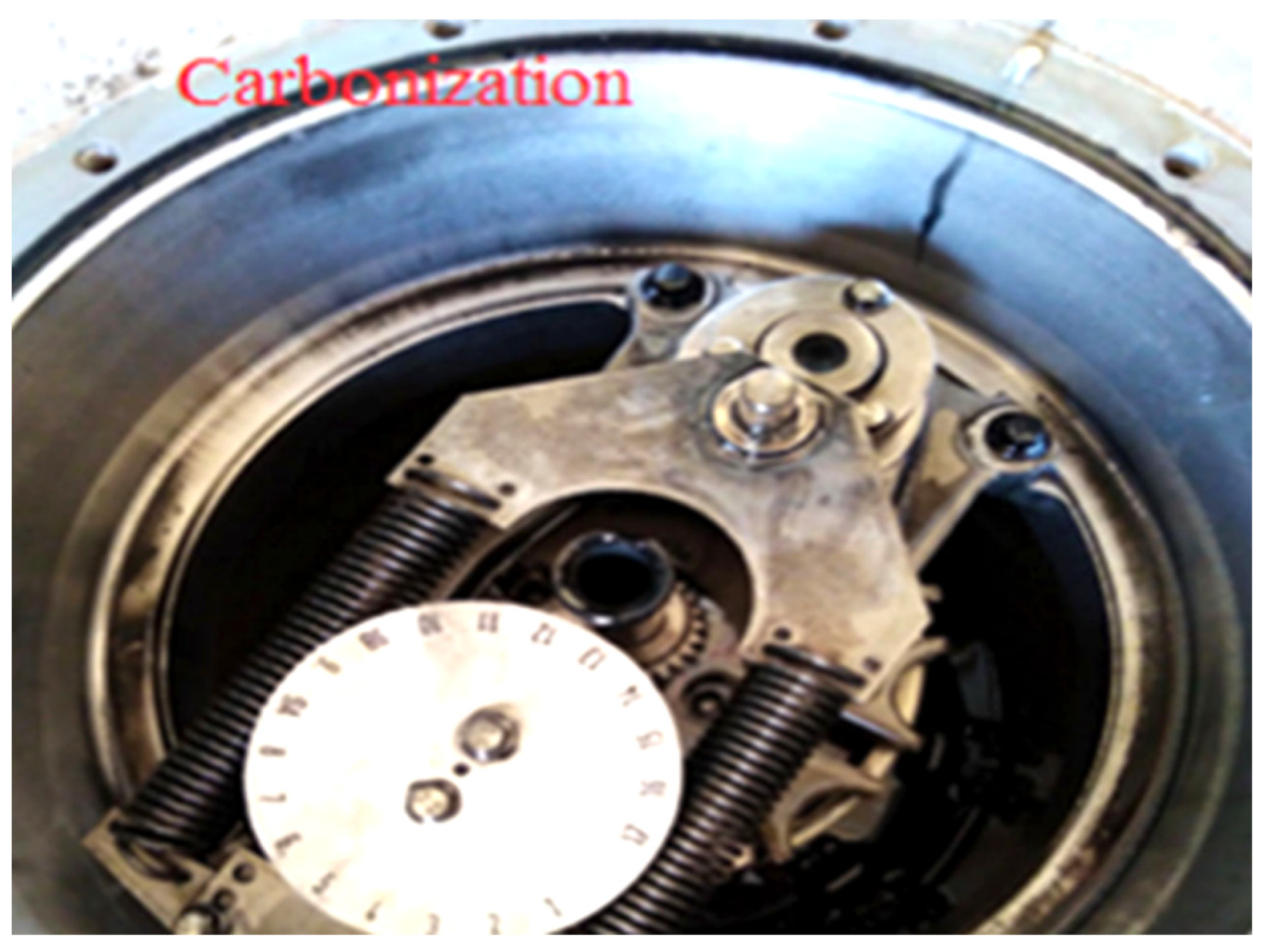
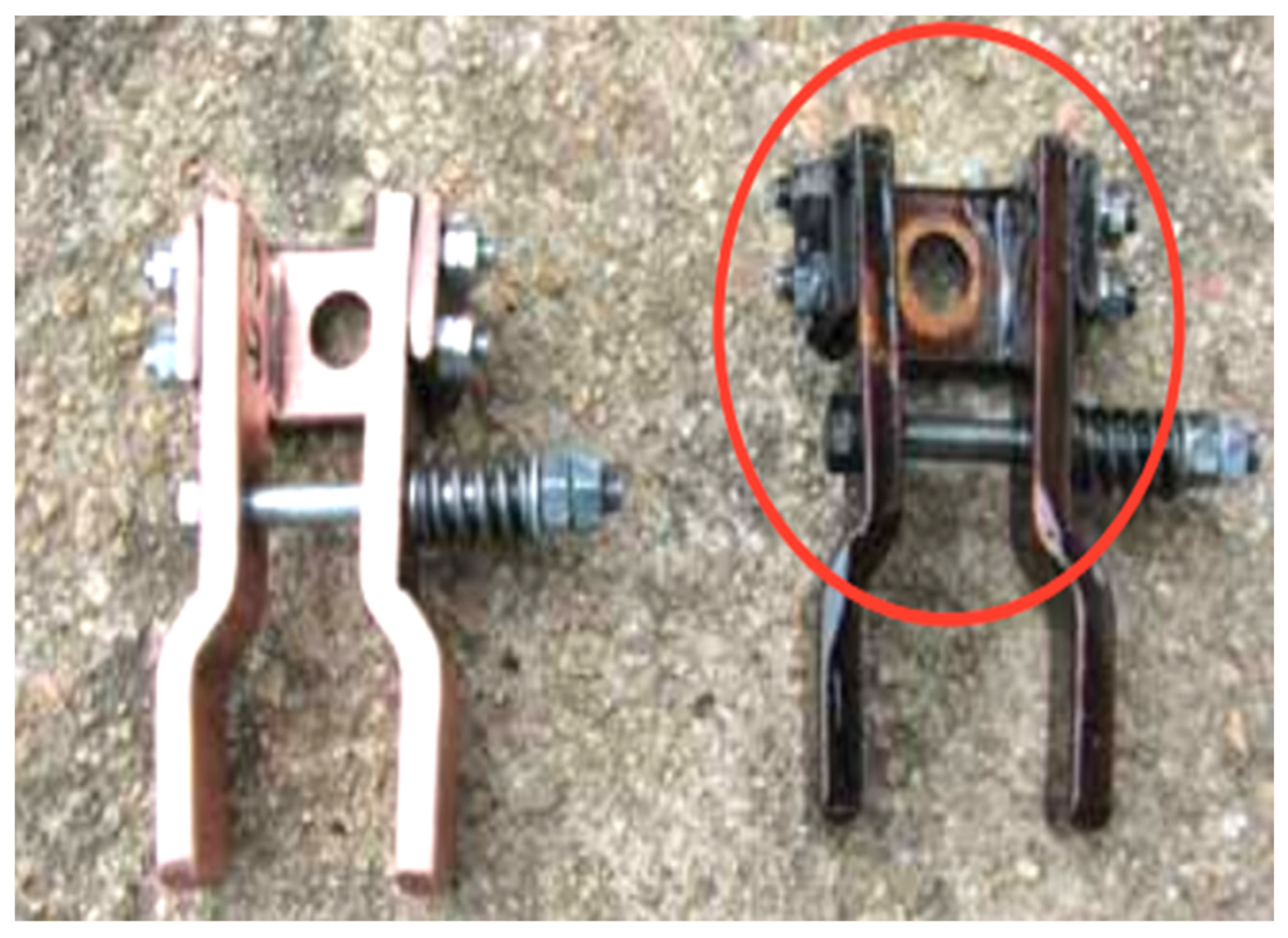

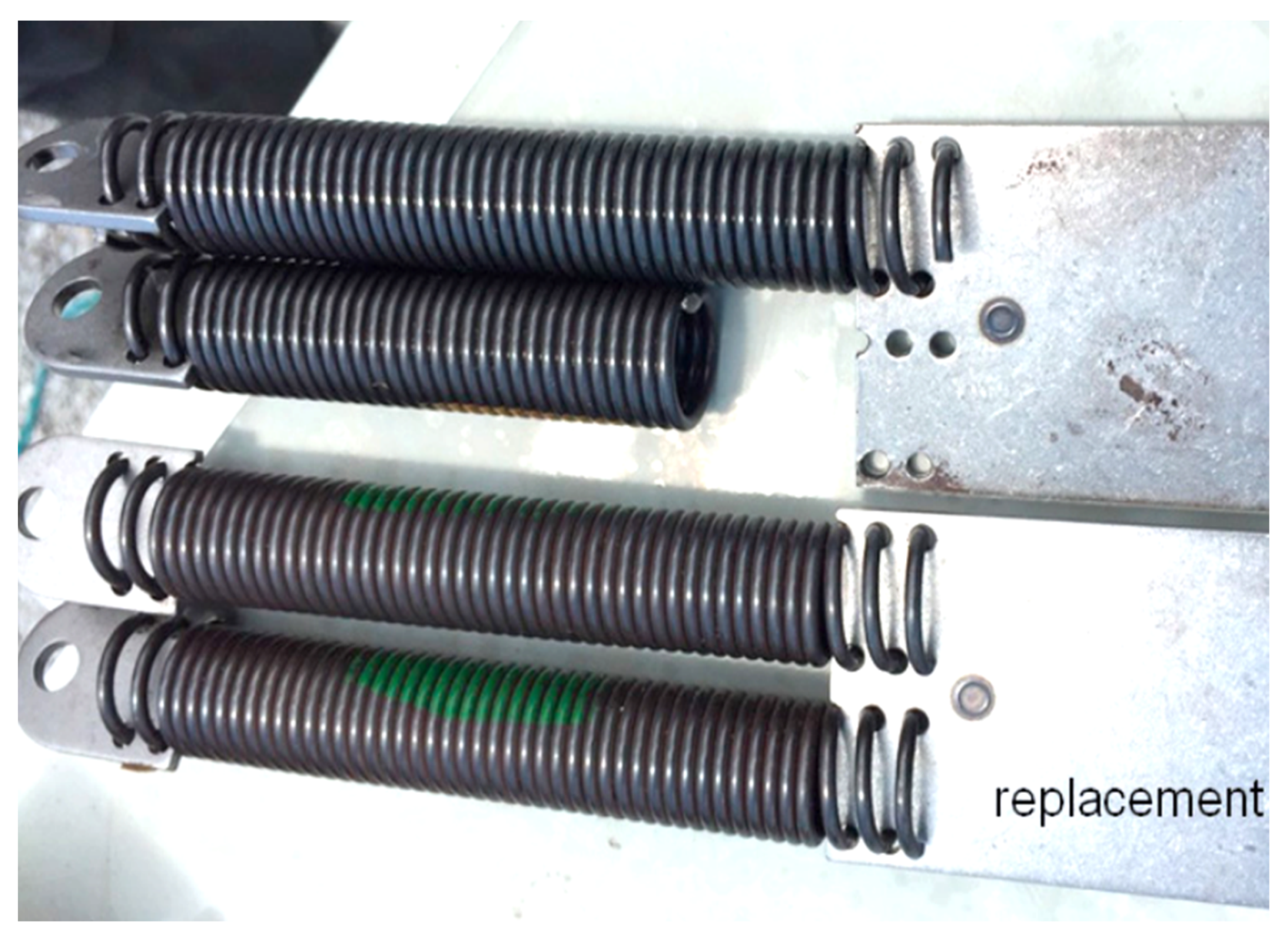
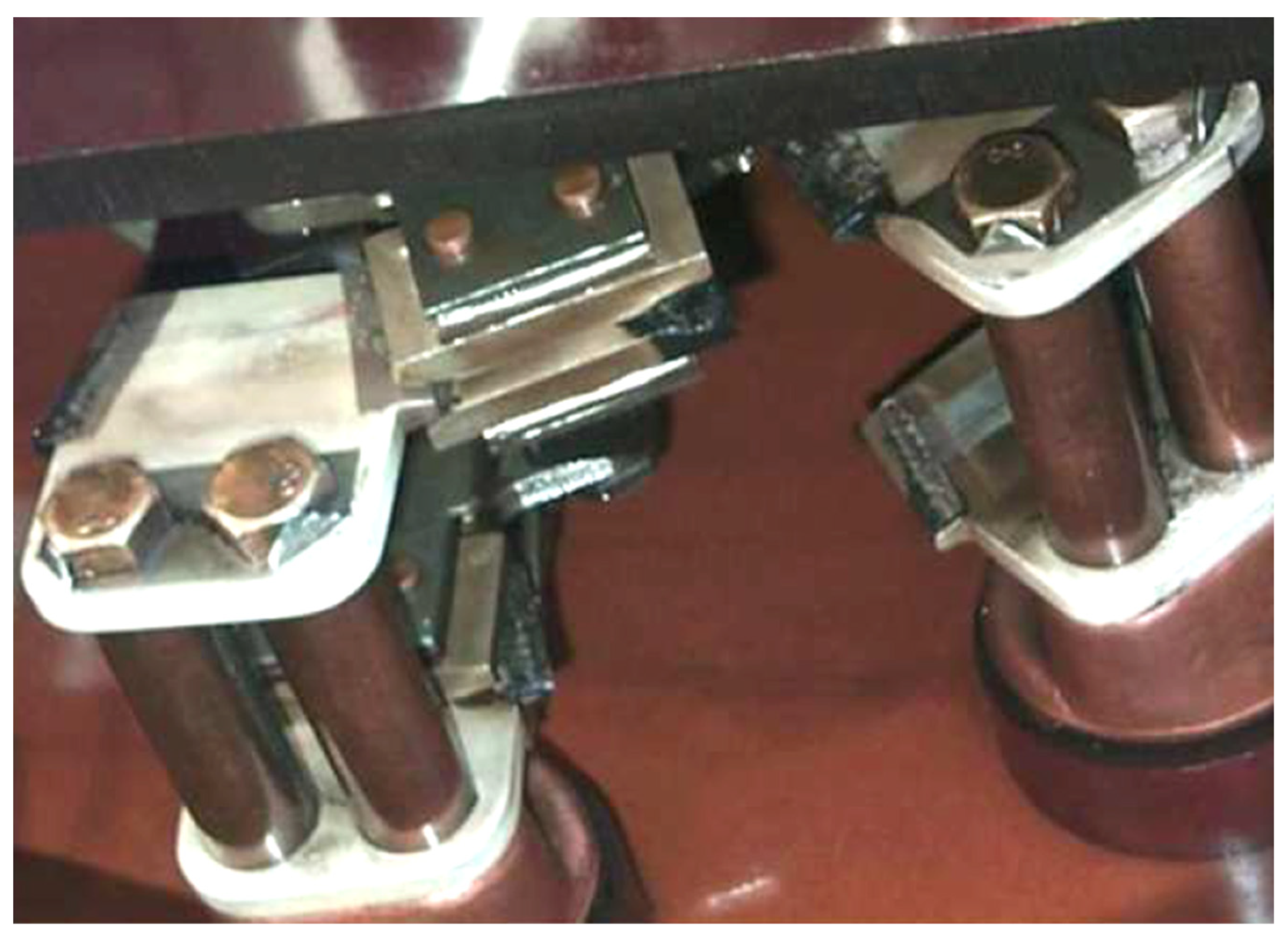
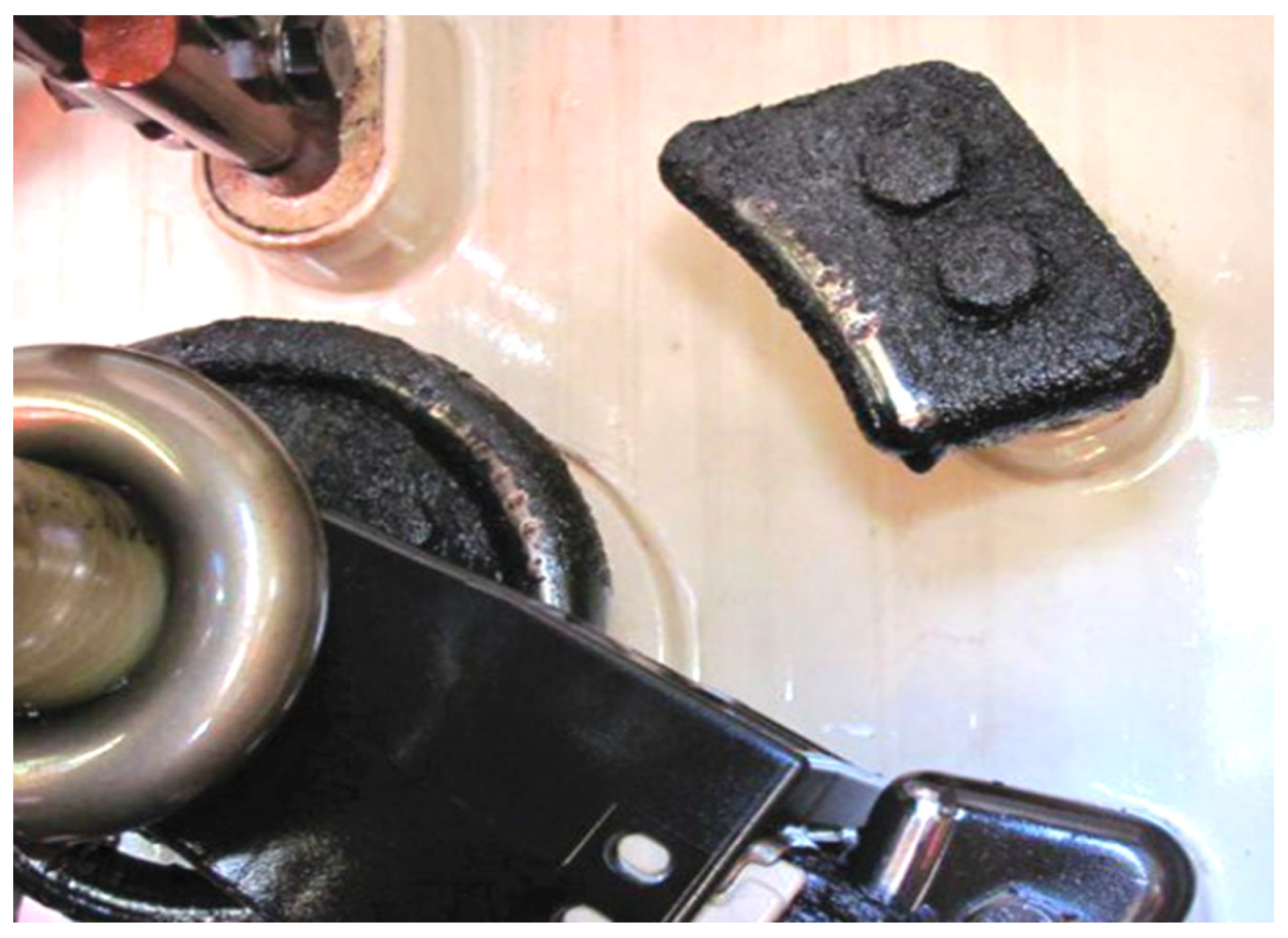

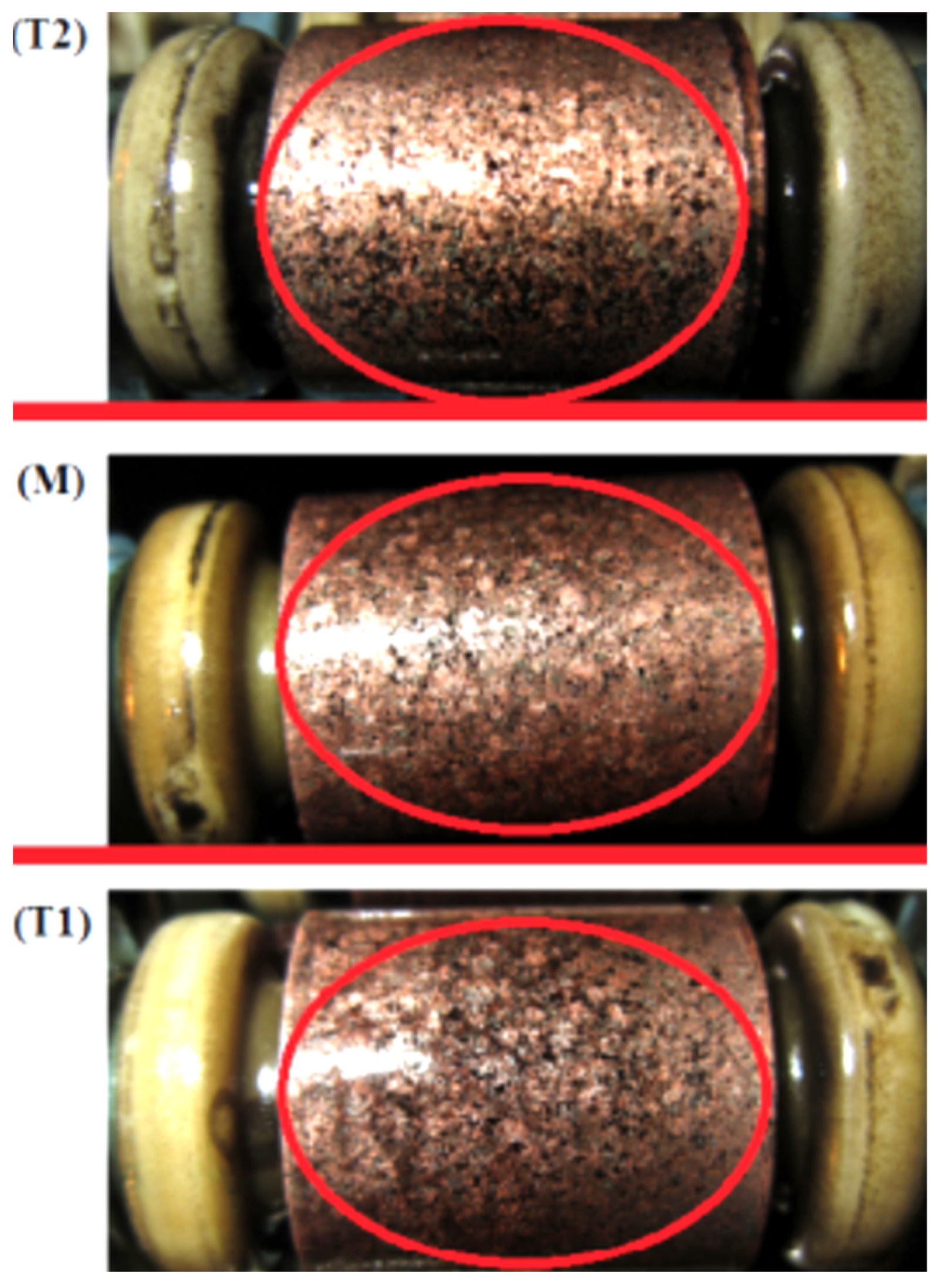
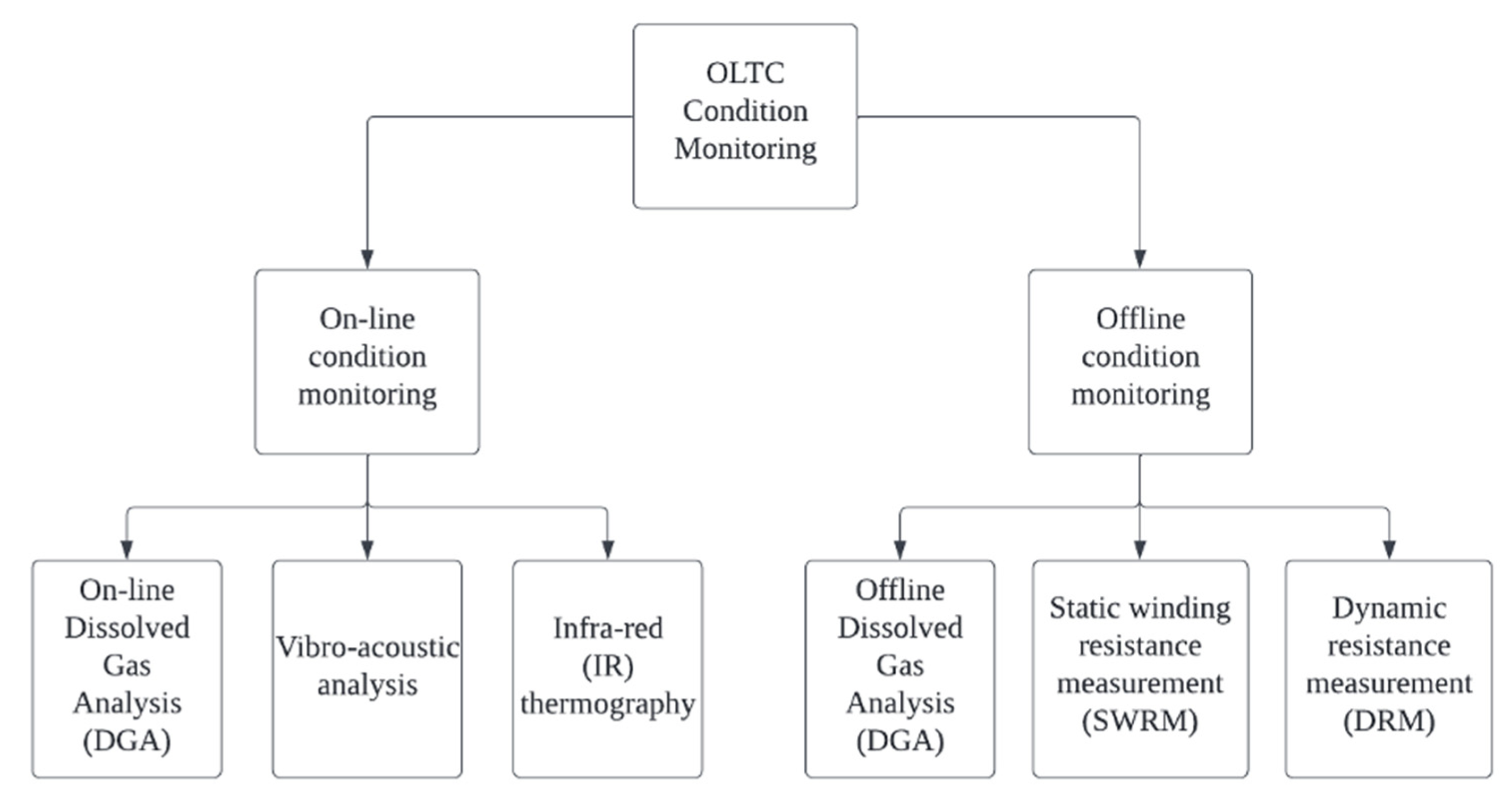

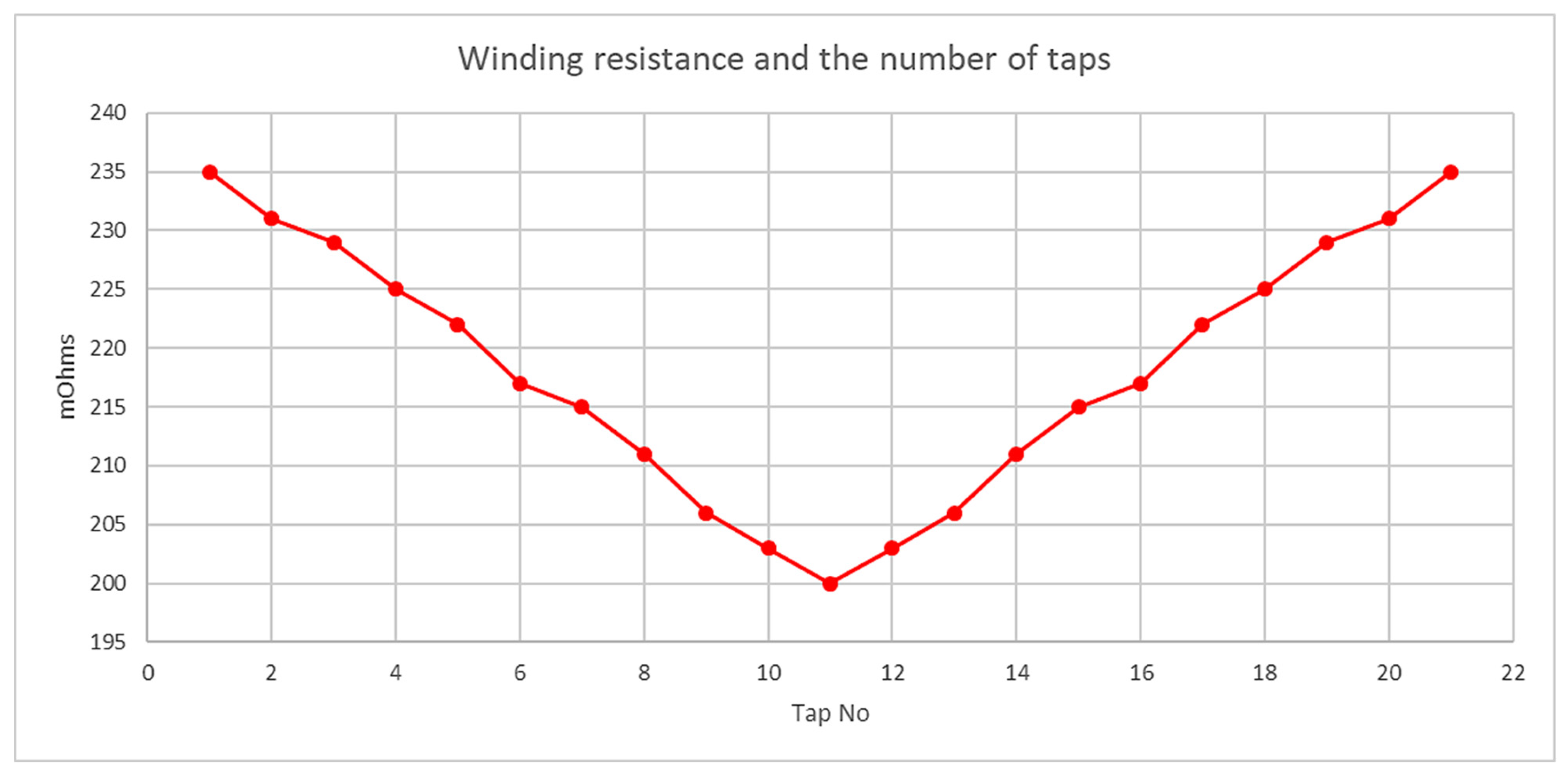
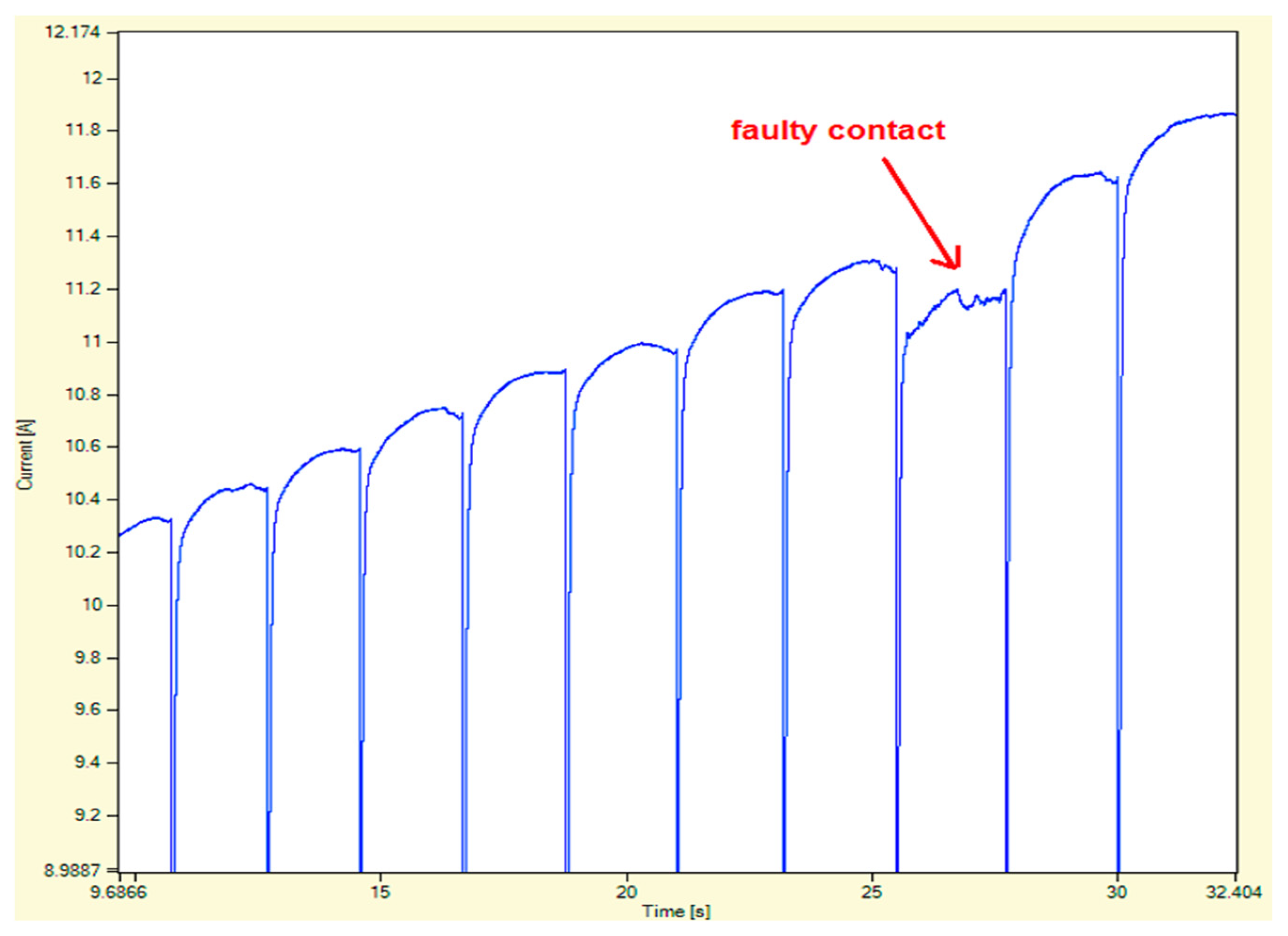

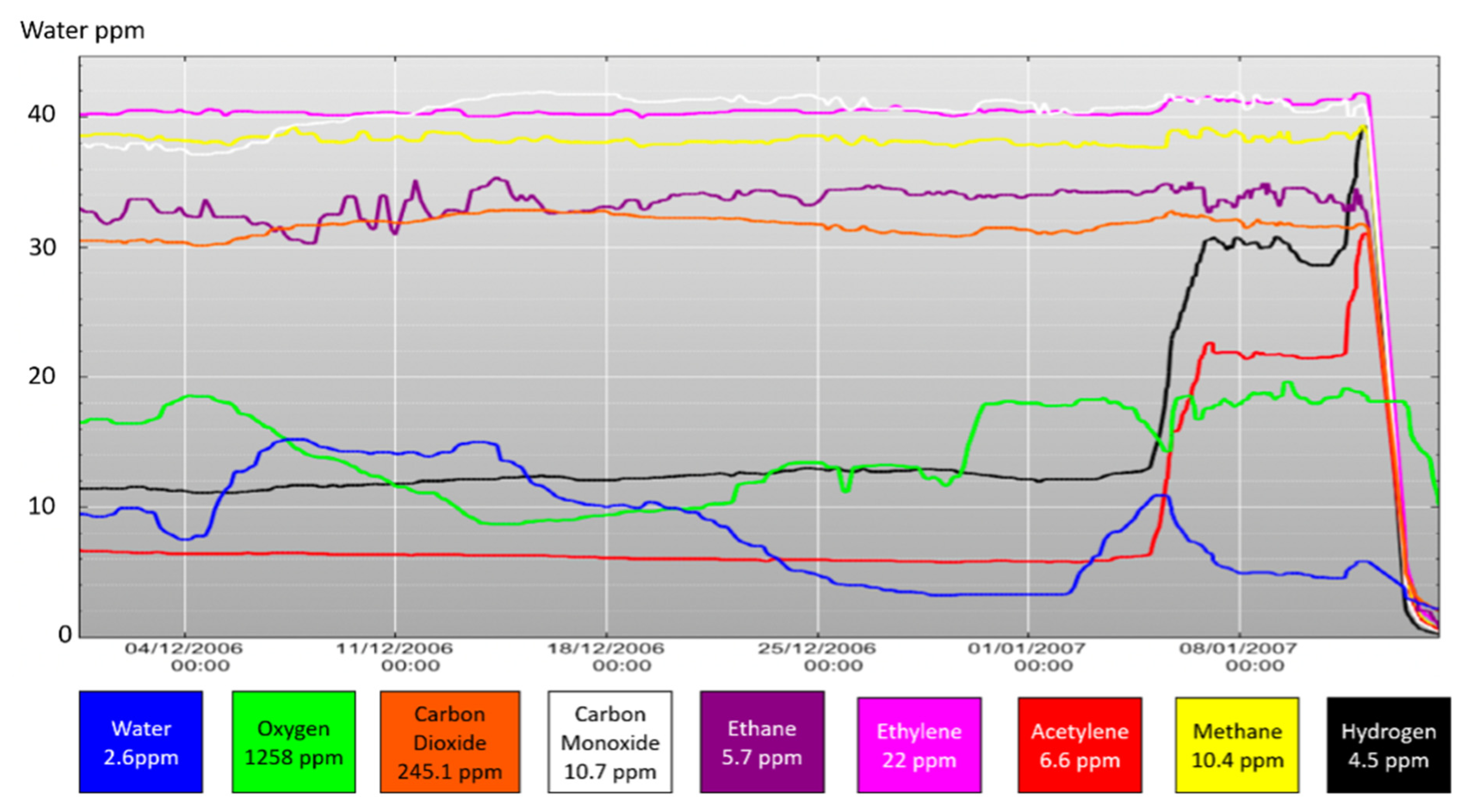
| Type of Incipient Fault | Visual Inspection |
|---|---|
| Partial discharge (PD) | Deposits of “X-wax” on paper insulation due to corona type or carbonized punctures in the paper caused by sparking, which could be challenging to detect. |
| Discharge of low energy (D1) | Carbonized punctures in the paper (pinholes), a trace of carbon particles in the oil, or surface of the paper is carbonized. |
| Discharges of high energy (D2) | Continuous destruction and severe carbonization of paper or metal fusion, severe carbonization in oil or tripping of the equipment indicate a large current follow-through. |
| Thermal fault, t < 300 °C (T1) | At below 300 °C, the insulation paper looks brownish. |
| Thermal fault, 300 °C < t < 700 °C (T2) | Between 300 °C and below 700 °C, insulation paper is carbonized. |
| Thermal fault, t > 700 °C (T3) | At above 700 °C, oil is severely carbonized, metal coloration (at 800 °C), or metal fusion (below 1000 °C). |
| Indication/Faults | Key Gasses | Other Traces of Gas |
|---|---|---|
| Cellulose ageing | CO, CO2, H2O | |
| Insulation oil decomposition | H2, CH4, C2H2, C2H4, C2H6 | |
| Leaks in gaskets, welds, etc. | CO2, O2, H2O | |
| Thermal faults-cellulose | H2, CO, CO2, CH4, O2 | |
| Thermal fault, t < 300 °C | H2, CH4, C2H6 | C2H4 |
| Thermal fault, 300 °C < t < 700 °C | H2, CH4, C2H4, C2H6 | C2H2 |
| Thermal fault, t > 700 °C | H2, CH4, C2H2, C2H4 | |
| Partial discharge | H2, CH4 | C2H2 |
| Arcing | H2, CH4, C2H2, C2H4 |
| Types of Electrical Fault | Root Cause | Consequences |
|---|---|---|
| Overheating | Electrical corrosion, wear, fatigue in spring mechanism, and mechanical failure of the rapid mechanism. | An increase of contact resistance which makes it hot and burned out. |
| Discharge faults | Presence of moisture content in the insulation oil due to leaky gaskets. A loose short circuit of the fastener will make the switch burn down or even explode. | The dielectric strength of insulation oil due to moisture becomes low, thus producing arcing and an increase in oil temperature [16]. The presence of silver sulphide also reduces the dielectric strength [17,18]. |
| Diagnostic Methods | Application/ Purpose | Problems | Advantage | Disadvantage |
|---|---|---|---|---|
| Offline dissolved gas analysis (DGA) | Detects higher concentrations of gases in the tap changer compartment | Arcing, overheating/coking | Great method for detecting an incipient fault | Needs to de-energize the OLTC. Cannot detect the actual location of the fault. Requires additional diagnosis to determine it. |
| Static winding resistance measurement (SWRM) | Checks the windings as well as the internal connections | Contacts alignment, contact wear | Easy to interpret | Needs to de-energize the OLTC. Does not measure the switching process of the diverter switch. Requires DRM. |
| Dynamic resistance measurement (DRM) | Measure the fast switching process of the diverter switch | Timing/sequence, contact wear, transition | Supplementary diagnosis for static winding resistance. Easy to diagnose and can be applied to any type of tap changer. | Needs to de-energize the OLTC. |
| Technology | Advantage | Disadvantage |
|---|---|---|
| Gas chromatography (GC) | Wide range of fault gases Highest accuracy and repeatability | Time-consuming Expensive Frequent calibrations needed |
| Photo-acoustic spectroscopy (PAS) | Wide range of fault gases Low maintenance | Results are sensitive to the wave Accuracy is influenced by temperature, pressure, and vibration Limited ability to measure high gas concentrations |
| Solid-state (IC) | Operates under extreme temperatures, vibration, or in corrosive atmospheres | Limited ability to detect very low gas concentrations |
| Thermal conductivity detector (TCD) | Fast response Stable Wide measuring range Simple construction Robust | Sensitive to interfering gases Reaction due to heating wire Heating element reacts with gas |
| Non-dispersive infrared (NDIR) | Simultaneous multi-gas measurement No required calibrations Low maintenance Fast gas measurement time | Limited ability to detect very low gas concentrations Interfering gases can affect the accuracy |
| Non-dispersive infrared (NDIR) | Uses only physical technique Can be used in an inert atmosphere | Not all gases have IR absorption More user’s expertise required |
| Diagnostic Methods | Application/ Purpose | Problems | Advantage(s)/Disadvantage(s) |
|---|---|---|---|
| Online dissolved gas analysis (DGA) | Detects higher concentrations of gases in the tap changer compartment | Arcing, overheating/coking | Heart of online fault detection system High-cost, non-destructive diagnostic tool |
| Vibro-acoustic analysis | Detects mechanical problems and ageing of the drive mechanism | Linkage/gears, timing/sequence, contacts alignment, arcing, overheating/coking, contact wear, transition | Complex nature of the acoustic propagation pathways Limited distance Ageing factors deteriorate the sensor |
| Infrared (IR) thermography | Detects temperature in parts of transformer | Abnormal heating of degraded contacts (coking, low pressure) | Images are difficult to interpret and specific objects having erratic temperatures |
Publisher’s Note: MDPI stays neutral with regard to jurisdictional claims in published maps and institutional affiliations. |
© 2022 by the authors. Licensee MDPI, Basel, Switzerland. This article is an open access article distributed under the terms and conditions of the Creative Commons Attribution (CC BY) license (https://creativecommons.org/licenses/by/4.0/).
Share and Cite
Ismail, F.B.; Mazwan, M.; Al-Faiz, H.; Marsadek, M.; Hasini, H.; Al-Bazi, A.; Yang Ghazali, Y.Z. An Offline and Online Approach to the OLTC Condition Monitoring: A Review. Energies 2022, 15, 6435. https://doi.org/10.3390/en15176435
Ismail FB, Mazwan M, Al-Faiz H, Marsadek M, Hasini H, Al-Bazi A, Yang Ghazali YZ. An Offline and Online Approach to the OLTC Condition Monitoring: A Review. Energies. 2022; 15(17):6435. https://doi.org/10.3390/en15176435
Chicago/Turabian StyleIsmail, Firas B., Maisarah Mazwan, Hussein Al-Faiz, Marayati Marsadek, Hasril Hasini, Ammar Al-Bazi, and Young Zaidey Yang Ghazali. 2022. "An Offline and Online Approach to the OLTC Condition Monitoring: A Review" Energies 15, no. 17: 6435. https://doi.org/10.3390/en15176435







